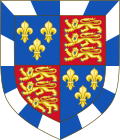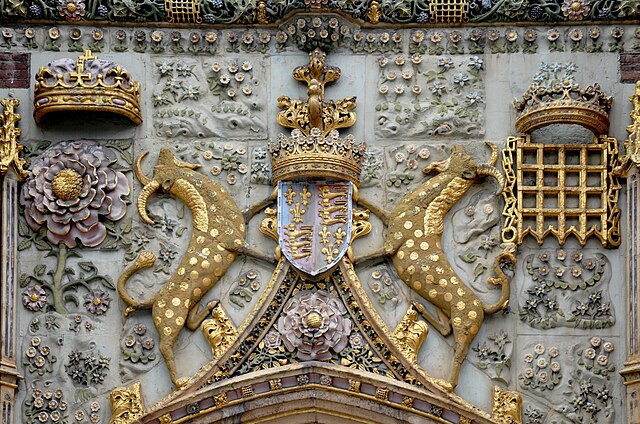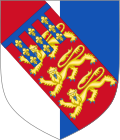Top Qs
Timeline
Chat
Perspective
House of Beaufort
English noble family From Wikipedia, the free encyclopedia
Remove ads
The House of Beaufort (/ˈboʊfərt/ BOH-fərt)[2] is an English noble family which originated in the fourteenth century as the legitimated issue of John of Gaunt, 1st Duke of Lancaster, by Katherine Swynford. Gaunt and Swynford had four children: John Beaufort, 1st Earl of Somerset (1373–1410); Cardinal Henry Beaufort (1375–1447), Bishop of Winchester; Thomas Beaufort, 1st Duke of Exeter (1377–1426) and Joan Beaufort, Countess of Westmorland (1379–1440).[3] When Gaunt finally married Swynford as his third wife in 1396, the Beauforts were legitimised by Pope Boniface IX and by royal proclamation of the reigning monarch King Richard II the following year.
This article needs additional citations for verification. (September 2014) |
Remove ads
John of Gaunt’s eldest legitimate son by his first wife Blanche of Lancaster was Henry Bolingbroke, who would eventually take the throne from Richard II as King Henry IV in 1399, the year of Gaunt’s death. Henry would be the first of the House of Lancaster (the main line descending from John of Gaunt) to rule England, and would eventually be succeeded by his son Henry V and grandson Henry VI. The Beauforts, as a junior branch of the House of Lancaster, would play an important role during the Wars of the Roses during the reign of the incompetent Henry VI. The eventual heiress of the Beaufort family was Lady Margaret Beaufort, only daughter of John Beaufort, 1st Duke of Somerset, who married Edmund Tudor, Earl of Richmond and became the mother of King Henry VII, the first Tudor monarch of England.
The name Beaufort refers to the estate of Montmorency-Beaufort in Champagne, France, an ancient and seemingly important possession of the House of Lancaster. It is earliest associated with Edmund Crouchback, 1st Earl of Lancaster (the younger son of King Henry III) whose third son John of Lancaster (1286–1317) was "Seigneur de Beaufort". The estate of Beaufort was eventually inherited, with other vast possessions, by John of Gaunt (third surviving son of King Edward III) following his marriage to the heiress Blanche of Lancaster.
The House of Beaufort continues to exist in an illegitimate line descended from Charles Somerset, 1st Earl of Worcester, the illegitimate son of Henry Beaufort, 3rd Duke of Somerset. The senior representative of the House of Beaufort is Henry Somerset, 12th Duke of Beaufort, who is thus a direct male-line descendant, albeit via a legitimated and an illegitimate line, of King Henry II, the first Plantagenet King of England.
Remove ads
History
Summarize
Perspective
The Beauforts were a powerful and wealthy family from the start, and rose to greater power after their half-brother became King Henry IV in 1399, having deposed his 1st cousin King Richard II. However, in 1406, Henry IV decided that although the Beauforts were legitimate, their line could not be used to make any claim to the throne. John Beaufort had already been created Earl of Somerset in 1397. His second son John became the first Duke of Somerset in 1443.[3]
The second son (of John of Gaunt), Henry, became a bishop, Lord Chancellor, and a Cardinal; the third son, Thomas, became Duke of Exeter; and the daughter, Joan, married Ralph Neville, 1st Earl of Westmorland, as his second wife. Joan's many descendants include the Dukes of York, Warwick the "Kingmaker", the Dukes of Norfolk, the Dukes of Buckingham, the Earls of Northumberland, and Catherine Parr, the last queen of Henry VIII.
When the dynastic struggle of the Wars of the Roses broke out in the later fifteenth century, the Beauforts were the chief supporters of Henry VI and the House of Lancaster.[4]
Henry VII traced his claim to the English crown through his mother, Margaret Beaufort, granddaughter of John Beaufort, 1st Earl of Somerset, and great-granddaughter of John of Gaunt.
The Beauforts suffered heavily in the Wars of the Roses. Edmund Beaufort, 2nd Duke of Somerset and his three elder sons (the 3rd and 4th Dukes and the Earl of Dorset), all lost their lives, leaving no legitimate male heir. The male line was however continued through Charles Somerset, 1st Earl of Worcester, the illegitimate son of Henry Beaufort, 3rd Duke of Somerset, who adopted the surname "Somerset" and used the arms of Beaufort but with a baton sinister for bastardy.[5]
Henry Somerset, 3rd Marquess of Worcester (1629–1700), sixth in descent from Charles Somerset, 1st Earl of Worcester, assisted in the Restoration of the Monarchy to King Charles II, who in 1682 created him Duke of Beaufort.[3] The title Duke of Somerset was no longer available, having been granted in 1547 by King Edward VI[6] to his uncle Edward Seymour, Lord Protector, which family and title survives today.
Thus the Beaufort family is today represented in the male line by its illegitimate continuation, the House of Somerset, whose senior representative is Henry Somerset, 12th Duke of Beaufort. The Somerset family has long borne the arms of Beaufort undifferenced, with the baton sinister adopted by Charles Somerset, 1st Earl of Worcester, discontinued.[7]
Remove ads
Notable Beauforts
Summarize
Perspective

These included:
- John Beaufort, 1st Earl of Somerset (c. 1371–1410).
- Henry Beaufort, 2nd Earl of Somerset (c. 1401–1418).
- John Beaufort, 1st Duke of Somerset (c. 1404–1444).
- Margaret Beaufort, Countess of Richmond and Derby (1443–1509), mother of King Henry VII of England
- Joan Beaufort, Queen of Scotland (c. 1404–1445)
- Thomas Beaufort, Count of Perche (c. 1405–1431)
- Edmund Beaufort, 2nd Duke of Somerset (c. 1406–1455).
- Henry Beaufort, 3rd Duke of Somerset (1436–1464).
- Margaret Beaufort, Countess of Stafford (c. 1427–1474)
- Edmund Beaufort, 4th Duke of Somerset (c. 1438–1471).
- John Beaufort, Marquess of Dorset (c. 1441–1471)
- Margaret Beaufort, Countess of Devon (1409–1449)
- Henry Beaufort (c. 1375–1447), Cardinal Bishop of Winchester
- Thomas Beaufort, Duke of Exeter (c. 1377–1426)
- Joan Beaufort, Countess of Westmorland (c. 1379–1440)
- Cecily Neville, Duchess of York (1415–1495), mother of Kings Edward IV and Richard III of England
Remove ads
Family tree
Coats of arms
Summarize
Perspective
   |
   |
  
|
|---|---|---|
John Beaufort, 1st Earl of Somerset |
Coat of Arms of Thomas Beaufort, Duke of Exeter |
John Beaufort, 1st Duke of Somerset |
Descendants of John Beaufort, 1st Earl of Somerset
Remove ads
Symbols of Beaufort
Summarize
Perspective

The House of Beaufort adopted various heraldic or quasi-heraldic symbols, badges or cognisances. These included:
- The Beaufort Portcullis, now the symbol of the House of Commons;
- The heraldic colours white and blue, an old symbol of the Earls of Lancaster,[1] shown componée;
- The Beaufort Yale, an heraldic beast used as supporters of the escutcheon;
- The Forget-me-Not flower (Myosotis sylvatica), a reference to the heraldic motto of Lady Margaret Beaufort Souvent me Souvient ("I often remember").[18] It is visible sculpted on the main gate of St John's College, Cambridge, founded by Lady Margaret Beaufort. The forget-me-not flower was possibly first used as the heraldic badge of King Henry IV, legitimate son and heir of John of Gaunt. One of Henry IV's mottos was souveyne vous de moi, the French name for the forget-me-not flower. Henry IV's accounts contain several references to this flower, for example "for mending a collar of the lord in the form of flowers of souveyne vous de moi … with a swan newly enamelled" and "for a collar of esses and flowers of souveyne vous de moys".[19]
Remove ads
References
Wikiwand - on
Seamless Wikipedia browsing. On steroids.
Remove ads

















